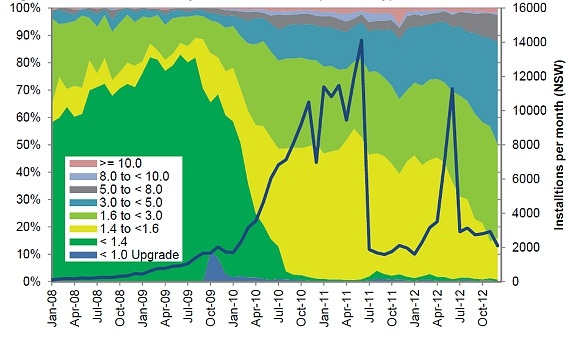Are solar buyers rational?
CORRECTION: An earlier version of this article stated that NSW closed their premium feed-in tariff scheme for solar PV in April 2010. It should have said April 2011.
Last year I predicted that the size of PV systems (the kilowatts of capacity) installed in Australia would decline as state governments lowered the price paid for generation exported to the grid to about 8 cents per kilowatt-hour (versus 20 cents, or even 60 cents, that used to be paid for exported generation).
The reason for my view was that while it represented a good financial return to invest in solar to displace electricity you were consuming from the grid (at an average of about 25c/kWh to even above 40c/kWh for some peak pricing structures), generation surplus to household needs represented a poor financial return at 8c/kWh. Systems of about 1.6 kilowatts or less would therefore gain popularity while the trend to larger systems would halt and in fact reverse.
I was badly wrong.
Overall there has been a trend to larger systems that I suspect is a function more of upfront costs to households, and the nature of the government’s upfront incentives, rather than detailed financial analysis.
To understand consumer behaviour it’s worthwhile firstly reviewing the rate of overall solar system installations in the last two years, as detailed in the chart below prepared by Green Energy Markets for the Clean Energy Regulator.
What immediately stands-out is the peak in installations towards the middle of the year across every single state. This is due to a rush by households to get a system before the step down timed for July in the level of the federal government rebate (reducing the renewable energy certificate or STC multiplier).
Number of PV systems installed by state

Source: Green Energy Markets (2013)
However changes in the feed-in tariff regimes are also important. If you look at NSW installations there is a clear step change between very high rates sustained across January to June 2011 well above other states (except for the May-June peak in Queensland) and then it precipitously drops off a cliff to a new much lower level below that of all the other major states that never recovers.
Victoria experiences two surges in September 2011 and September 2012 associated with changes in the feed-in tariff regime. And of course Queensland has maintained quite high installations rates post the June 2012 peak that it didn’t see in 2011 as PV suppliers gradually work through a backlog of customer orders that rushed in prior to the dropping of the 44c/kWh feed-in tariff.
What is interesting though is that in spite of a nationwide move to dramatically reduce feed-in tariffs, the average system size has trended noticeably and steadily upward. I suspect this is about households placing a heavy weight on upfront costs over life of system revenue.
The chart below from Green Energy Markets shows a step change around July 2010 away from systems less than 1.4kW (the dark green) to systems between 1.4 and 1.6 (yellow). This was clearly driven by the government dropping the $8000 rebate which cut out at 1kW and introducing the solar certificate multiplier which cut out at 1.5kW.
Australia-wide distribution of solar PV installations by capacity of system (in kilowatts)

Source: Green Energy Markets (2013)
But what’s interesting is that from around mid-2011 onwards, the dominance of the 1.4-1.6kW systems also falls away in favour of bigger systems, even though the wind back of feed-in tariffs commenced at this time. While the trend towards bigger systems is more pronounced in Queensland, where the 44 cent feed-in tariff has continued to provide a strong financial incentive up until recently, it is also clearly apparent in NSW (see chart below) who moved first to cut-back their premium feed-in tariff in April 2011.
NSW distribution of solar PV installations by capacity of system (in kilowatts)

Source: Green Energy Markets (2013)
This does not make sense from a purely rational perspective. While circumstances will differ between households depending on energy usage patterns, it’s likely householders will export a very large fraction of the extra generation they gain from going beyond 2kW.
However householders aren’t purely rational financial calculators. While feed-in tariffs are an influence on their decision-making, they tend to be extremely focussed on upfront costs.
In the past the government’s solar multiplier meant that there was a big step change in costs for going beyond 1.5kW. This made many baulk, even though the revenue from feed-in tariffs was brilliant. But as the solar multiplier has been scaled-back, the differential per unit of capacity from a smaller versus larger system has narrowed, as illustrated below.
Customer out of pocket cost per kW for different sized systems

Source: Green Energy Markets (2013)
Also householders tend to apply some rules of thumb about what they can and can’t afford to pay for household items. While a 3kW system may have been a better financial bet than 1.5kW when feed-in tariffs were in the realm of 44 to 60 cents, an upfront cost beyond $10,000 induced sticker shock. Now even 5kW systems are offered under the mental barrier of $10,000.
Householders’ decision making around purchasing of a solar system is clearly more complex than a financial spreadsheet calculation with a myriad of factors affecting 1) whether or not to install solar and 2) how big a system they choose to install.
















